The Role of Working Memory in Early Literacy and Numeracy Skills in Kindergarten and First Grade
Highlights
- Working memory is important for learning processes and the development of new skills.
- Working memory is related to early literacy and numeracy in kindergarten children and academic skills at older ages.
- The study examines the unique connections among working memory, early literacy, and early numeracy using various assessment tests.
- Complex working memory is more significant in the first grade in regard to both mathematics and language skills, while simple working memory is important for early numeracy in kindergarten.
Abstract
:1. The Role of Working Memory in Early Literacy and Numeracy Skills in Kindergarten and First Grade
1.1. Rationale
1.2. Theoretical Background
1.2.1. Working Memory
1.2.2. Development of Mathematical Skills
1.2.3. Development of Language Skills
1.2.4. The Contribution of Working Memory to Mathematical Learning
1.2.5. The Contribution of Working Memory to Language Learning
1.3. The Current Study
2. Method
2.1. Participants
2.2. Measures
2.2.1. Early Numeracy in Kindergarten and Math Skills in First Grade
2.2.2. Early Literacy
2.2.3. Simple Working Memory Skills
Verbal Auditory Memory Tests
Auditory-Visual Memory
Visual Spatial Memory
2.2.4. Complex WM Skills
Complex Visual Spatial WM
Complex Verbal Auditory WM
2.3. Procedure
2.4. Data Analysis
3. Results
3.1. Measurement Models
3.1.1. Early Literacy and Language Skills with Memory Abilities
3.1.2. Early Numeracy and Mathematical Skills with Memory Abilities
3.2. Structural Models
3.3. Complex WM
3.3.1. Early Numeracy and Mathematics Skills
Simple WM
Complex WM
4. Discussion
4.1. Contribution of the Simple Memory System to Numeracy and Language Skills
4.2. Contribution of the Complex WM System to Numeracy and Language Skills
5. Conclusions
5.1. Educational Impact and Implications
5.2. Limitations and Implications for Future Studies
Author Contributions
Funding
Institutional Review Board Statement
Informed Consent Statement
Data Availability Statement
Acknowledgments
Conflicts of Interest
References
- Baddeley, A.D.; Hitch, G.J. Working memory. In Recent Advances in Learning and Motivation; Bower, G.A., Ed.; Academic Press: New York, NY, USA, 1974; Volume 8, pp. 47–90. [Google Scholar] [CrossRef]
- Peng, P.; Namkung, J.M.; Barnes, M.; Sun, C. A meta-analysis of mathematics and working memory: Moderating effects of working memory domain, type of mathematics skill, and sample characteristics. J. Educ. Psychol. 2016, 108, 455–473. [Google Scholar] [CrossRef]
- Reynolds, M.R.; Niileksela, C.R.; Gignac, G.E.; Sevillano, C.N. Working memory capacity development through childhood: A longitudinal analysis. Dev. Psychol. 2022, 58, 1254–1263. [Google Scholar] [CrossRef] [PubMed]
- De Vita, C.; Costa, H.M.; Tomasetto, C.; Passolunghi, M.C. The contributions of working memory domains and processes to early mathematical knowledge between preschool and first grade. Psychol. Res. 2021, 86, 497–511. [Google Scholar] [CrossRef] [PubMed]
- Fanari, R.; Meloni, C.; Massidda, D. Visual and spatial working memory abilities predict early math skills: A longitudinal study. Front. Psychol. 2019, 10, 2460. [Google Scholar] [CrossRef] [Green Version]
- Hilbert, S.; Bruckmaier, G.; Binder, K.; Krauss, S.; Bühner, M. Prediction of elementary mathematics grades by cognitive abilities. Eur. J. Psychol. Educ. 2019, 34, 665–683. [Google Scholar] [CrossRef]
- Baddeley, A.D. The episodic buffer: A new component of working memory? Trends Cogn. Sci. 2000, 4, 417–423. [Google Scholar] [CrossRef]
- Gathercole, S.E.; Dunning, D.L.; Holmes, J.; Norris, D. Working memory training involves learning new skills. J. Mem. Lang. 2019, 105, 19–42. [Google Scholar] [CrossRef]
- Peng, P.; Kievit, R.A. The development of academic achievement and cognitive abilities: A bidirectional perspective. Child Dev. Perspect. 2020, 14, 15–20. [Google Scholar] [CrossRef]
- Dehaene, S.; Cohen, L. Towards an anatomical and functional model of number processing. Math. Cogn. 1995, 1, 83–120. [Google Scholar]
- Aunio, P.; Räsänen, P. Core numerical skills for learning mathematics in children aged five to eight years—A working model for educators. Eur. Early Child. Educ. Res. J. 2016, 24, 684–704. [Google Scholar] [CrossRef]
- Aunio, P. Early numeracy skills learning and learning difficulties—Evidence-based assessment and interventions. Math. Cogn. Learn. 2019, 5, 195–214. [Google Scholar] [CrossRef]
- Inoue, T.; Manolitsis, G.; de Jong, P.F.; Landerl, K.; Parrila, R.; Georgiou, G.K. Home literacy environment and early literacy development across languages varying in orthographic consistency. Front. Psychol. 2020, 11, 1923. [Google Scholar] [CrossRef] [PubMed]
- Teale, W.H.; Whittingham, C.E.; Hoffman, E.B. Early literacy research, 2006–2015: A decade of measured progress. J. Early Child. Lit. 2020, 20, 169–222. [Google Scholar] [CrossRef]
- Share, D.L. Common misconceptions about the phonological deficit theory of dyslexia. Brain Sci. 2021, 11, 1510. [Google Scholar] [CrossRef]
- Wasserstein, D.; Lipka, O. Predictive examination of phonological awareness among Hebrew-speaking kindergarten children. Front. Psychol. 2019, 10, 1809. [Google Scholar] [CrossRef] [PubMed]
- Landerl, K.; Castles, A.; Parrila, R. Cognitive precursors of reading: A cross-linguistic perspective. Sci. Stud. Read. 2022, 26, 111–124. [Google Scholar] [CrossRef]
- Bar-On, A.; Datner, E.; Ravid, D. Context effect on resolving heterophonic-homography in learning to read Hebrew. Read. Writ. 2017, 30, 463–487. [Google Scholar] [CrossRef]
- Caravolas, M.; Lervåg, A.; Mikulajová, M.; Defior, S.; Seidlová-Málková, G.; Hulme, C. A cross-linguistic, longitudinal study of the foundations of decoding and reading comprehension ability. Sci. Stud. Read. 2019, 23, 386–402. [Google Scholar] [CrossRef]
- Esmaeeli, Z.; Kyle, F.E.; Lundetræ, K. Contribution of family risk, emergent literacy and environmental protective factors in children’s reading difficulties at the end of second-grade. Read. Writ. 2019, 32, 2375–2399. [Google Scholar] [CrossRef] [Green Version]
- Passolunghi, M.C.; Lanfranchi, S.; Altoè, G.; Sollazzo, N. Early numerical abilities and cognitive skills in kindergarten children. J. Exp. Child Psychol. 2015, 135, 25–42. [Google Scholar] [CrossRef]
- Bisagno, E.; Cadamuro, A.; Morra, S. Multiple influences of working memory capacity on number comprehension: The interplay with metacognition and number-specific prerequisites. J. Exp. Child Psychol. 2023, 226, 105568. [Google Scholar] [CrossRef]
- Bull, R.; Espy, K.A.; Wiebe, S.A. Short-term memory, working memory, and executive functioning in preschoolers: Longitudinal predictors of mathematical achievement at age 7 years. Dev. Neuropsychol. 2008, 33, 205–228. [Google Scholar] [CrossRef] [PubMed] [Green Version]
- Namkung, J.M.; Fuchs, L.S. Cognitive predictors of calculations and number line estimation with whole numbers and fractions among at-risk students. J. Educ. Psychol. 2016, 108, 214–228. [Google Scholar] [CrossRef] [PubMed]
- Raghubar, K.P.; Barnes, M.A.; Hecht, S.A. Working memory and mathematics: A review of developmental, individual difference, and cognitive approaches. Learn. Individ. Differ. 2010, 20, 110–122. [Google Scholar] [CrossRef]
- Geary, D.C. Cognitive predictors of achievement growth in mathematics: A 5-year long longitudinal study. Dev. Psychol. 2011, 47, 1539–1552. [Google Scholar] [CrossRef] [Green Version]
- Peng, P.; Namkung, J.M.; Fuchs, D.; Fuchs, L.S.; Patton, S.; Yen, L.; Compton, D.L.; Zhang, W.; Miller, A.; Hamlett, C. A longitudinal study on predictors of early calculation development among young children at risk for learning difficulties. J. Exp. Child Psychol. 2016, 152, 221–241. [Google Scholar] [CrossRef] [PubMed] [Green Version]
- Gathercole, S.; Woolgar, F.; Kievit, R.A.; Duncan, A.; Manly, T.; Holmes, J. How common are WM deficits in children with difficulties in reading and mathematics? J. Appl. Res. Mem. Cogn. 2016, 5, 384–394. [Google Scholar] [CrossRef] [Green Version]
- Miller-Cotto, D.; Byrnes, J.P. What’s the best way to characterize the relationship between working memory and achievement?: An initial examination of competing theories. J. Educ. Psychol. 2020, 112, 1074–1084. [Google Scholar] [CrossRef]
- Meyer, M.L.; Salimpoor, V.N.; Wu, S.S.; Geary, D.C.; Menon, V. Differential contribution of specific working memory components to mathematics achievement in 2nd and 3rd graders. Learn. Individ. Differ. 2010, 20, 101–109. [Google Scholar] [CrossRef] [Green Version]
- Caviola, S.; Colling, L.J.; Mammarella, I.C.; Szűcs, D. Predictors of mathematics in primary school: Magnitude comparison, verbal and spatial working memory measures. Dev. Sci. 2020, 23, e12957. [Google Scholar] [CrossRef]
- Geary, D.C.; Hoard, M.K.; Nugent, L.; Byrd-Craven, J. Development of number line representations in children with mathematical learning disability. Dev. Neuropsychol. 2008, 33, 277–299. [Google Scholar] [CrossRef] [PubMed] [Green Version]
- Jordan, N.C.; Glutting, J.; Ramineni, C.; Watkins, M.W. Validating a number sense screening tool for use in kindergarten and first grade: Prediction of mathematics proficiency in third grade. Sch. Psychol. Rev. 2010, 39, 181–195. [Google Scholar] [CrossRef]
- Foster, M.E.; Anthony, J.L.; Clements, D.H.; Sarama, J.H. Processes in the development of mathematics in kindergarten children from Title 1 schools. J. Exp. Child Psychol. 2015, 140, 56–73. [Google Scholar] [CrossRef] [Green Version]
- Ding, Y.; Liu, R.D.; Hong, W.; Yu, Q.; Wang, J.; Liu, Y.; Zhen, R. Specific mental arithmetic difficulties and general arithmetic learning difficulties: The role of phonological working memory. Psychol. Rep. 2021, 124, 720–751. [Google Scholar] [CrossRef]
- Martin, R.B.; Cirino, P.T.; Sharpa, C.; Barnes, M. Number and counting skills in kindergarten as predictors of grade 1 mathematical skills. Learn. Individ. Differ. 2014, 34, 12–23. [Google Scholar] [CrossRef] [PubMed]
- Rasmussen, C.; Bisanz, J. Representation and working memory in early arithmetic. J. Exp. Child Psychol. 2005, 91, 137–157. [Google Scholar] [CrossRef] [PubMed]
- Friso-van den Bos, I.; Kroesbergen, E.H.; Van Luit, J.E.H. Number sense in kindergarten children: Factor structure and working memory predictors. Learn. Individ. Differ. 2014, 33, 23–29. [Google Scholar] [CrossRef]
- Passolunghi, M.C.; Costa, H.M. Working memory and early numeracy training in preschool children. Child Neuropsychol. 2016, 22, 81–98. [Google Scholar] [CrossRef]
- Kroesbergen, E.H.; Van Luit, J.E.H.; Van Lieshout, E.C.D.M.; Van Loosbroek, E.V.; Van de Rijt, B.A.M. Individual differences in early numeracy. The role of executive functions and subitizing. J. Psychoeduc. Assess. 2009, 27, 226–236. [Google Scholar] [CrossRef]
- LeFevre, J.A.; Fast, L.; Skwarchuk, S.L.; Smith-Chant, B.L.; Bisanz, J.; Kamawar, D.; Penner-Wilger, M. Pathways to mathematics: Longitudinal predictors of performance. Child Dev. 2010, 81, 1753–1767. [Google Scholar] [CrossRef]
- Purpura, D.J.; Ganley, C.M. Working memory and language: Skill-specific or domain-general relations to mathematics? J. Exp. Child Psychol. 2014, 122, 104–121. [Google Scholar] [CrossRef] [PubMed]
- Purpura, D.J.; Schmitt, S.A.; Ganley, C.M. Foundations of mathematics and literacy: The role of executive functioning components. J. Exp. Child Psychol. 2017, 153, 15–34. [Google Scholar] [CrossRef] [PubMed]
- Ne’eman, A.; Shaul, S. The Association between Emergent Literacy and Cognitive Abilities in Kindergarten Children. Child Youth Care Forum 2023, 52, 467–488. [Google Scholar] [CrossRef]
- Gathercole, S.E.; Alloway, T.P.; Willis, C.; Adams, A.M. Working memory in children with reading disabilities. J. Exp. Child Psychol. 2006, 93, 265–281. [Google Scholar] [CrossRef] [Green Version]
- Peng, P.; Fuchs, D. A meta-analysis of working memory deficits in children with learning difficulties: Is there a difference between verbal domain and numerical domain? J. Learn. Disabil. 2016, 49, 3–20. [Google Scholar] [CrossRef] [Green Version]
- Alloway, T.P.; Gathercole, S.E. Working memory and classroom learning. Psychologist 2004, 15, 4–9. Available online: https://www.researchgate.net/publication/254392644 (accessed on 28 May 2023).
- Moll, K.; Gobel, S.M.; Gooch, D.; Landerl, K.; Snowling, M.J. Cognitive risk factors for specific learning disorder: Processing speed, temporal processing, and working memory. J. Learn. Disabil. 2016, 49, 272–281. [Google Scholar] [CrossRef]
- Kibby, M.Y.; Marks, W.; Morgan, S.; Long, C.J. Specific impairments in developmental reading disabilities: A working memory approach. J. Learn. Disabil. 2004, 37, 349–363. [Google Scholar] [CrossRef]
- Menghini, D.; Finzi, A.; Carlesimo, G.A.; Vicari, S. Working memory impairment in children with developmental dyslexia: Is it just a phonological deficit? Dev. Neuropsychol. 2011, 36, 199–213. [Google Scholar] [CrossRef]
- Pickering, S.J.; Gathercole, S.E. Distinctive working memory profiles in children with special educational needs. Educ. Psychol. 2004, 24, 393–408. [Google Scholar] [CrossRef]
- Johann, V.; Könen, T.; Karbach, J. The unique contribution of working memory, inhibition, cognitive flexibility, and intelligence to reading comprehension and reading speed. Child Neuropsychol. 2020, 26, 324–344. [Google Scholar] [CrossRef] [PubMed]
- De Jong, P.F. Working memory deficits of reading disabled children. J. Exp. Child Psychol. 1998, 70, 75–96. [Google Scholar] [CrossRef] [PubMed]
- Smythe, I.; Everatt, J.; Éva Gyarmathy, E.; Suk-Han Ho, C.; Groeger, J.A. Short-term memory and literacy: A cross-language comparison. Educ. Child Psychol. 2003, 20, 37–50. Available online: https://www.researchgate.net/publication/250928054 (accessed on 28 May 2023). [CrossRef]
- Alloway, T.P.; Gathercole, S.E.; Pickering, S.J. Verbal and visuospatial short-term and working memory in children: Are they separable? Child Dev. 2006, 77, 1698–1716. [Google Scholar] [CrossRef] [Green Version]
- Baddeley, A.D. Is working memory still working? Eur. Psychol. 2002, 7, 85–97. [Google Scholar] [CrossRef]
- Purpura, D.J.; Humeb, L.E.; Sims, D.M.; Lonigan, C.J. Early literacy and early numeracy: The value of including early literacy skills in the prediction of numeracy development. J. Exp. Child Psychol. 2011, 110, 647–658. [Google Scholar] [CrossRef]
- Van der Kooy-Hofland, V.A.; Van der Kooy, J.; Bus, A.G.; van IJzendoorn, M.H.; Bonsel, G.J. Differential susceptibility to early literacy intervention in children with mild perinatal adversities: Short-and long-term effects of a randomized control trial. J. Educ. Psychol. 2012, 104, 337. [Google Scholar] [CrossRef]
- Torgesen, J.K.; Rashotte, C.A.; Wagner, R.K. TOWRE: Test of Word Reading Efficiency; Pro-ed.: Austin, TX, USA, 1999. [Google Scholar]
- Wechsler, D. Manual for the Wechsler Intelligence Scale for Children–Third Edition (WISC–III); The Psychological Corporation: San Antonio, TX, USA, 1991. [Google Scholar]
- Alloway, T.P.; Gathercole, S.E.; Adams, A.M.; Willis, C.; Eaglen, R.; Lamont, E. Working memory and phonological awareness as predictors of progress towards early learning goals at school entry. Br. J. Dev. Psychol. 2005, 23, 417–426. [Google Scholar] [CrossRef] [Green Version]
- Kaufman, A.S.; Kaufman, N.L. Kaufman Assessment Battery for Children–Second Edition (K-ABC-II); American Guidance Service: Circle Pines, MN, USA, 2004. [Google Scholar]
- Nicolson, R.I.; Fawcett, A.J. The Dyslexia Early Screening Test-Second Edition (DEST-2); The Psychological Corporation: London, UK, 2004. [Google Scholar]
- Bayliss, D.M.; Jarrold, C.; Gunn, D.M.; Baddeley, A.D. The complexities of complex span: Explaining individual differences in working memory in children and adults. J. Exp. Psychol. Gen. 2003, 132, 71. [Google Scholar] [CrossRef]
- McInerney, R.J.; Hrabok, M.; Kerns, K.A. The children’s size-ordering task: A new measure of nonverbal working memory. J. Clin. Exp. Neuropsychol. 2005, 27, 735–745. [Google Scholar] [CrossRef] [PubMed]
- Teo, T. Using Structural Equation Modeling (SEM) in educational research: Practices and issues. Int. J. Appl. Educ. Stud. 2011, 10, 49–65. [Google Scholar]
- Barnes, M.A.; Clemens, N.H.; Fall, A.M.; Roberts, G.; Klein, A.; Starkey, P.; McCandliss, B.; Zucker, T.; Flynn, K. Cognitive predictors of difficulties in math and reading in pre-kindergarten children at high risk for learning disabilities. J. Educ. Psychol. 2020, 112, 685–700. [Google Scholar] [CrossRef]
- Honoré, N.; Noël, M.P. Can working memory training improve preschoolers’ numerical abilities? J. Numer. Cogn. 2017, 3, 516–539. [Google Scholar] [CrossRef] [Green Version]
- Kroesbergen, E.H.; Van’t Noordende, J.E.; Kolkman, M.E. Training working memory in kindergarten children: Effects on working memory and early numeracy. Child Neuropsychol. 2014, 20, 23–37. [Google Scholar] [CrossRef] [PubMed]
- Kyttälä, M.; Kanerva, K.; Munter, I.; Björn, P.M. Working memory resources in children: Stability and relation to subsequent academic skills. Educ. Psychol. 2019, 39, 709–728. [Google Scholar] [CrossRef]
- Ketelsen, K.; Welsh, M. Working memory and mental arithmetic: A case for dual central executive resources. Brain Cogn. 2010, 74, 203–209. [Google Scholar] [CrossRef]
- Peng, P.; Barnes, M.; Wang, C.; Wang, W.; Li, S.; Swanson, H.L.; Dardick, W.; Tao, S. A meta-analysis on the relation between reading and working memory. Psychol. Bull. 2018, 144, 48–76. [Google Scholar] [CrossRef]
- Friso-van den Bos, I.; Van der Ven, S.H.G.; Kroesbergen, E.H.; Van Luit, J.E.H. Working memory and mathematics in primary school children: A meta-analysis. Educ. Res. Rev. 2013, 10, 29–44. [Google Scholar] [CrossRef]
- Noël, M.P. Counting on working memory when learning to count and to add: A preschool study. Dev. Psychol. 2009, 45, 1630–1643. [Google Scholar] [CrossRef]
- Welsh, J.A.; Nix, R.L.; Blair, C.; Bierman, K.L.; Nelson, K.E. The development of cognitive skills and gains in academic school readiness for children from low-income families. J. Educ. Psychol. 2010, 102, 43–53. [Google Scholar] [CrossRef] [Green Version]
- Woodrome, S.E.; Johnson, K.E. The role of visual discrimination in the learning-to-read process. Read. Writ. 2009, 22, 117–131. [Google Scholar] [CrossRef]
- Allen, K.; Giofrè, D.; Higgins, S.; Adams, J. Working memory predictors of mathematics across the middle primary school years. J. Educ. Psychol. 2020, 90, 848–869. [Google Scholar] [CrossRef] [PubMed] [Green Version]
- Melby-Lervåg, M.; Lyster, S.A.H.; Hulme, C. Phonological skills and their role in learning to read: A meta-analytic review. Psychol. Bull. 2012, 138, 322–352. [Google Scholar] [CrossRef] [PubMed]
- Bonifacci, P.; Trambagioli, N.; Bernabini, L.; Tobia, V. Home activities and cognitive skills in relation to early literacy and numeracy: Testing a multifactorial model in preschoolers. Eur. J. Psychol. Educ. 2021, 37, 681–705. [Google Scholar] [CrossRef]
- Engel de Abreu, P.M.J.; Gathercole, S.E.; Martin, R. Disentangling the relationship between working memory and language: The roles of short-term storage and cognitive control. Learn. Individ. Differ. 2011, 21, 569–574. [Google Scholar] [CrossRef]
- Bourke, L.; Davies, S.J.; Sumner, E.; Green, C. Individual differences in the development of early writing skills: Testing the unique contribution of visuo-spatial working memory. Read. Writ. 2013, 27, 315–335. [Google Scholar] [CrossRef]
- Xenidou-Dervou, I.; De Smedt, B.; van der Schoot, M.; van Lieshout, E.C.D.M. Individual differences in kindergarten math achievement: The integrative roles of approximation skills and working memory. Learn. Individ. Differ. 2013, 28, 119–129. [Google Scholar] [CrossRef] [Green Version]
- Passolunghi, M.C.; Mammarella, I.C. Selective spatial working memory impairment in a group of children with mathematics learning disabilities and poor problem-solving skills. J. Learn. Disabil. 2012, 45, 341–350. [Google Scholar] [CrossRef] [Green Version]
- Soto-Calvo, E.; Simmons, F.R.; Willis, C.; Adams, A.M. Identifying the cognitive predictors of early counting and calculation skills: Evidence from a longitudinal study. J. Exp. Child Psychol. 2015, 140, 16–37. [Google Scholar] [CrossRef]
- McKenzie, B.; Bull, R.; Gray, C. The effects of phonological and visual-spatial interference on children’s arithmetic performance. Educ. Child Psychol. 2003, 20, 93–108. [Google Scholar] [CrossRef]
- Kolkman, M.E.; Kroesbergen, E.H.; Leseman, P.P.M. Involvement of working memory in longitudinal development of number–magnitude skills. Infant Child Dev. 2014, 23, 36–50. [Google Scholar] [CrossRef]
- Gathercole, S.E.; Tiffany, C.; Briscoe, J.; Thorn, A. The ALSPAC Team Developmental consequences of poor phonological short-term Memory function in childhood: A longitudinal study. J. Child Psychol. Psychiatry 2005, 46, 598–611. [Google Scholar] [CrossRef]
- Alloway, T.P. How does working memory work in the classroom? Educ. Res. Rev. 2006, 1, 134–139. [Google Scholar]
- Oakhill, J.; Kyle, F. The relation between phonological awareness and working memory. J. Exp. Child Psychol. 2000, 75, 152–164. [Google Scholar] [CrossRef]
- Bowey, J.A. Nonword repetition and young children’s receptive vocabulary: A longitudinal study. Appl. Psycholinguist. 2001, 22, 441–469. [Google Scholar] [CrossRef]
- Geary, D.C.; Hoard, M.K.; Hamson, C.O. Numerical and arithmetical cognition: Patterns of functions and deficits in children at risk for a mathematical disability. J. Exp. Child Psychol. 1999, 74, 213–239. [Google Scholar] [CrossRef] [PubMed] [Green Version]
- Passolunghi, M.C.; Siegel, L.S. Working memory and access to numerical information in children with disability in mathematics. J. Exp. Child Psychol. 2004, 88, 348–367. [Google Scholar] [CrossRef] [PubMed]
- Swanson, H.L.; Jerman, O. Math disabilities: A selective meta-analysis of the literature. Rev. Educ. Res. 2006, 76, 249–274. [Google Scholar] [CrossRef]
- Gersten, R.; Jordan, N.C.; Flojo, J.R. Early identification and interventions for students with mathematic difficulties. J. Learn. Disabil. 2005, 38, 293–304. [Google Scholar] [CrossRef] [Green Version]
- Toll, S.W.M.; Van Luit, E.H.V. The development of early numeracy ability in kindergartners with limited working memory skills. Learn. Individ. Differ. 2013, 25, 45–54. [Google Scholar] [CrossRef]
- Passolunghi, M.C.; Lanfranchi, S. Domain-specific and domain-general precursors of mathematical achievement: A longitudinal study from kindergarten to first grade. Br. J. Educ. Psychol. 2012, 82, 42–63. [Google Scholar] [CrossRef]
- Kyttälä, M.; Aunio, P.; Hautamäki, J. Working memory resources in young children with mathematical difficulties. Scand. J. Psychol. 2010, 51, 1–15. [Google Scholar] [CrossRef] [PubMed]
- Passolunghi, M.C.; Costa, H.M. Working memory and mathematical learning. In International Handbook of Mathematical Learning Difficulties; Springer: Cham, Switzerland, 2019; pp. 407–421. [Google Scholar] [CrossRef]
- Davis, N.; Sheldon, L.; Colmar, S.H. Memory mates: A classroom-based intervention to improve attention and working memory. Aust. J. Guid. Couns. 2014, 24, 111–120. [Google Scholar] [CrossRef]
- Byrnes, J.P.; Wasik, B.A. Factors predictive of mathematics achievement in kindergarten, first and third grades: An opportunity–propensity analysis. Contemp. Educ. Psychol. 2009, 34, 167–183. [Google Scholar] [CrossRef]
- Adams, A.M.; Gathercole, S.E. Phonological working memory and speech production in pre-school children. J. Speech Hear. Res. 1995, 38, 403–414. [Google Scholar] [CrossRef] [PubMed]
- Adams, A.M.; Gathercole, S.E. Limitations in working memory: Implications for language development. Int. J. Lang. Commun. Disord. 2000, 35, 95–116. [Google Scholar] [CrossRef] [PubMed]

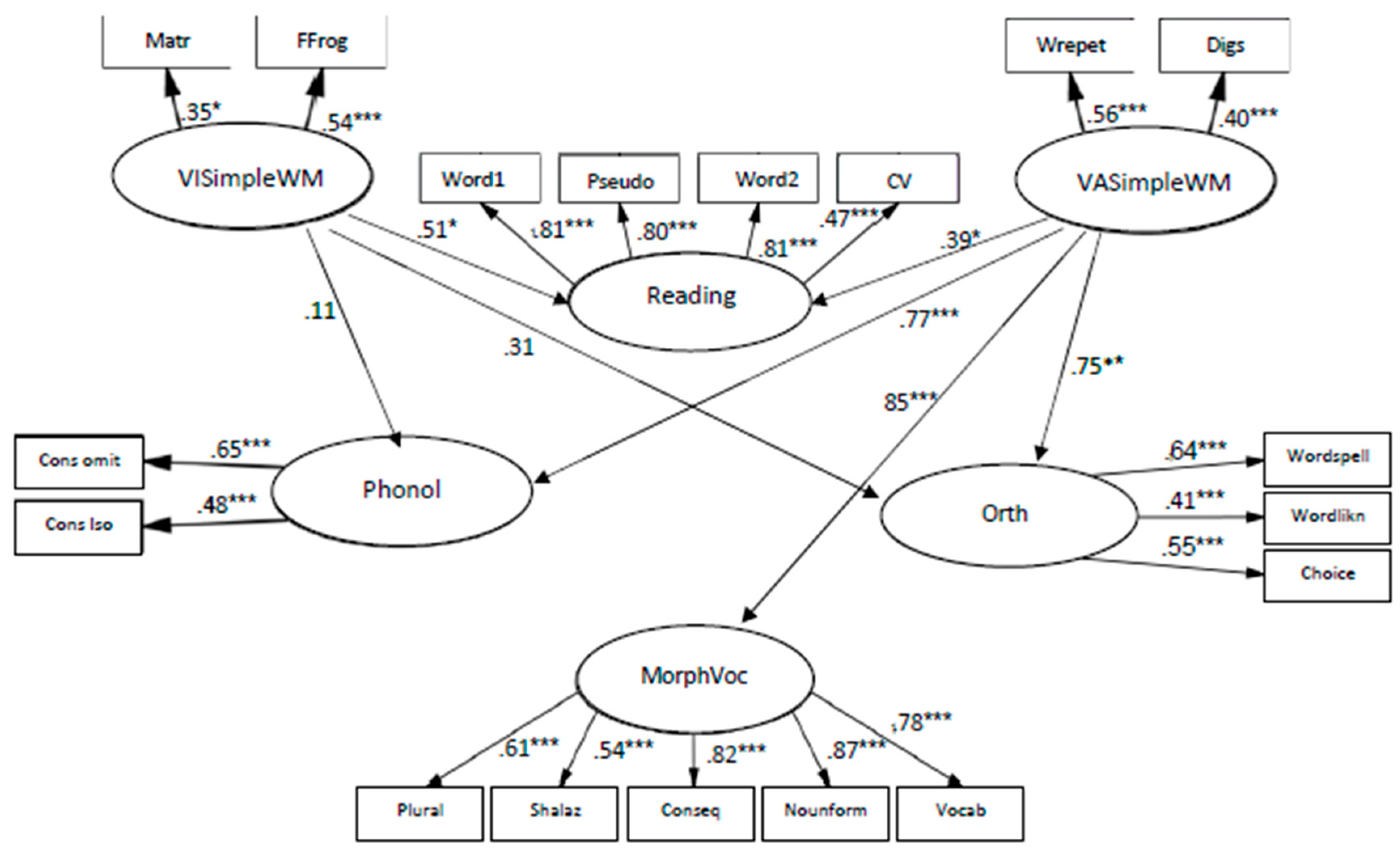


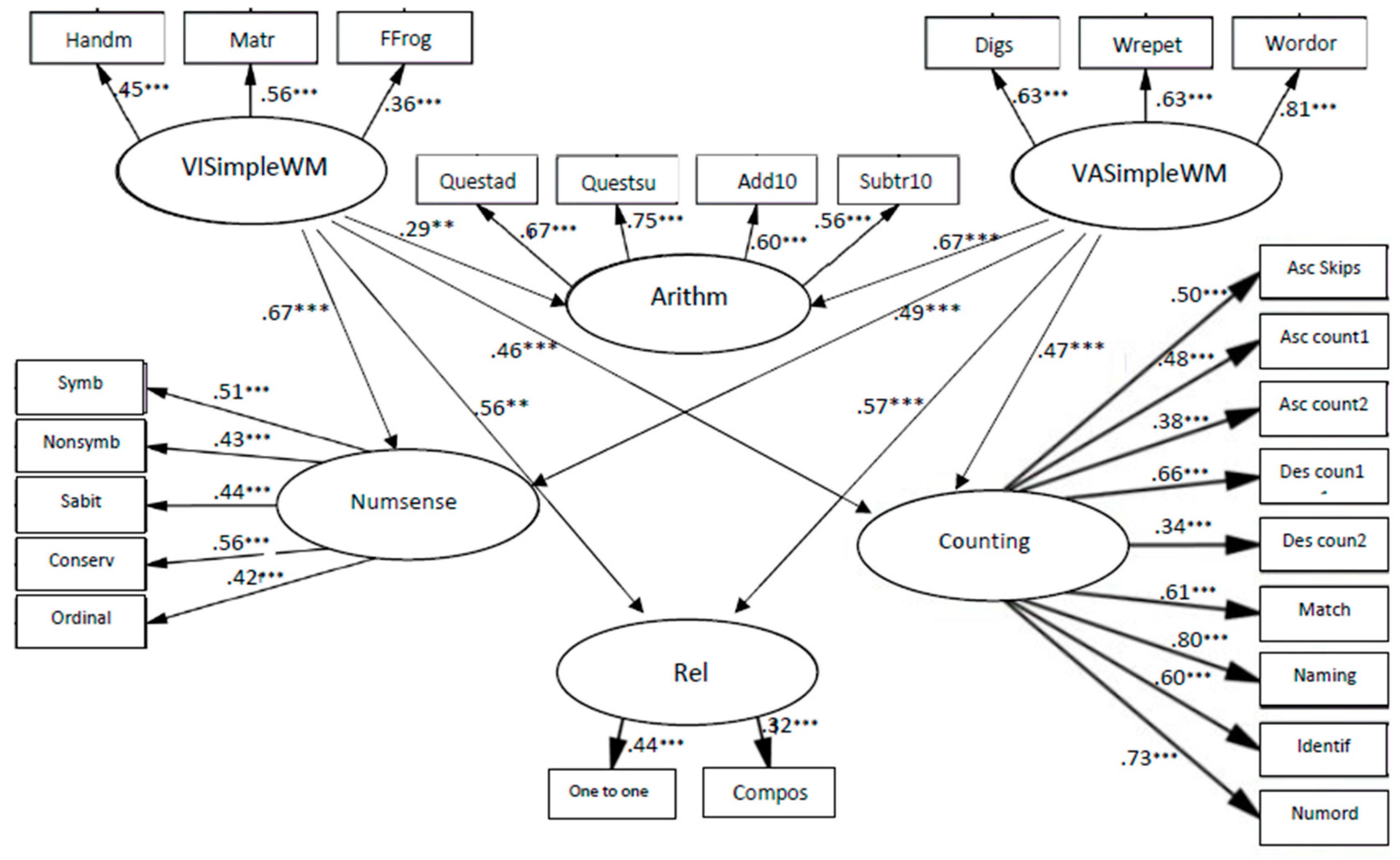
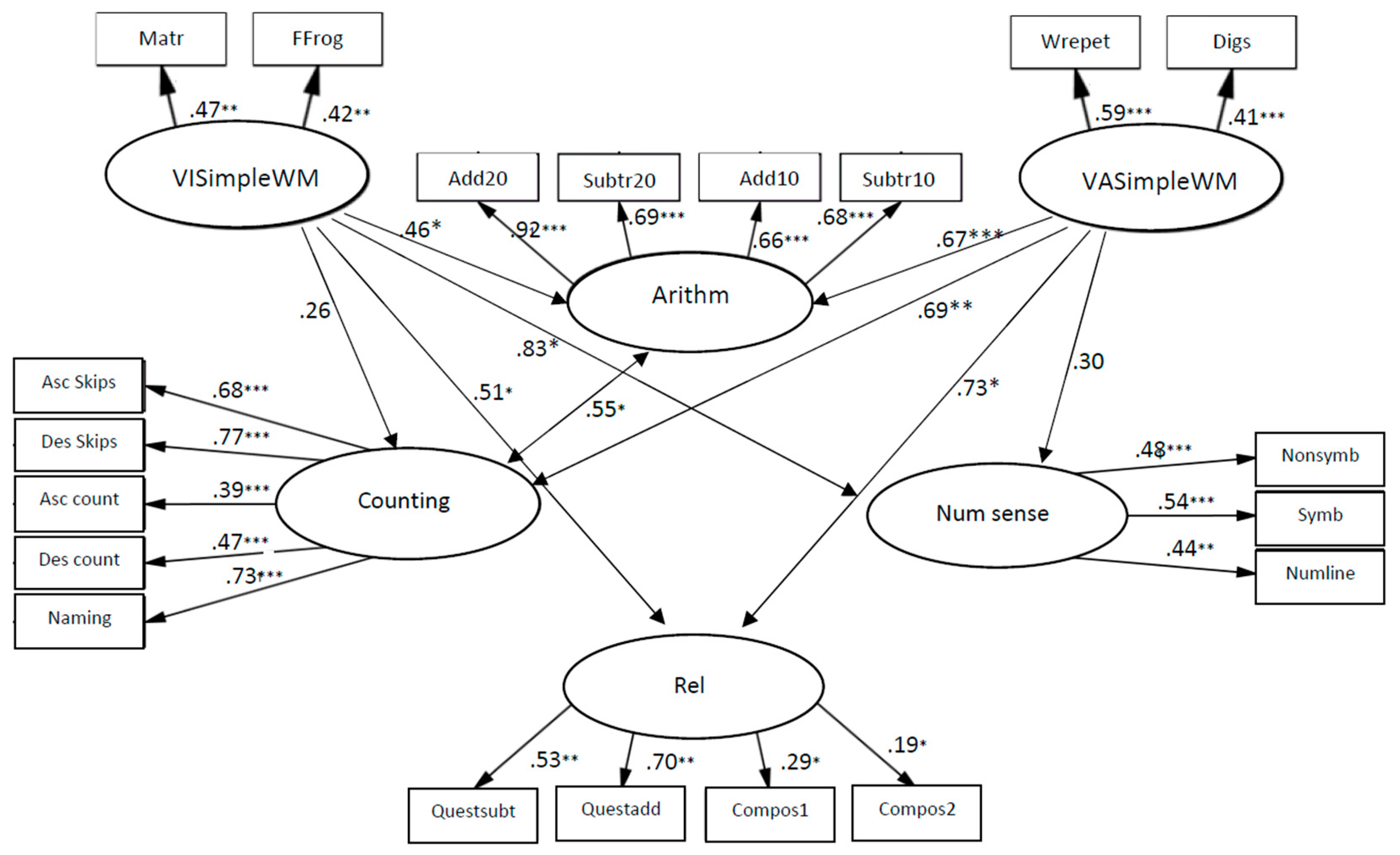

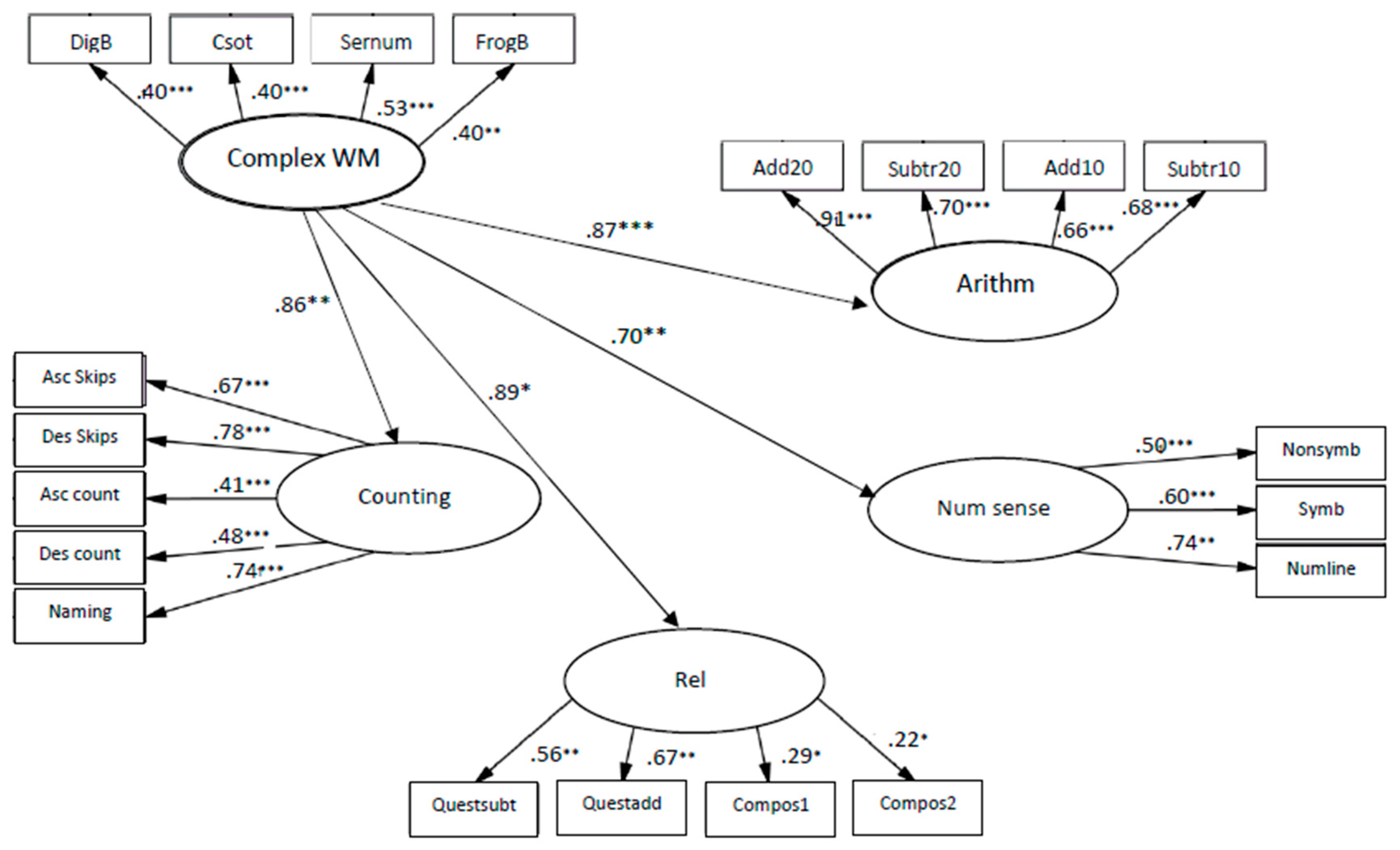
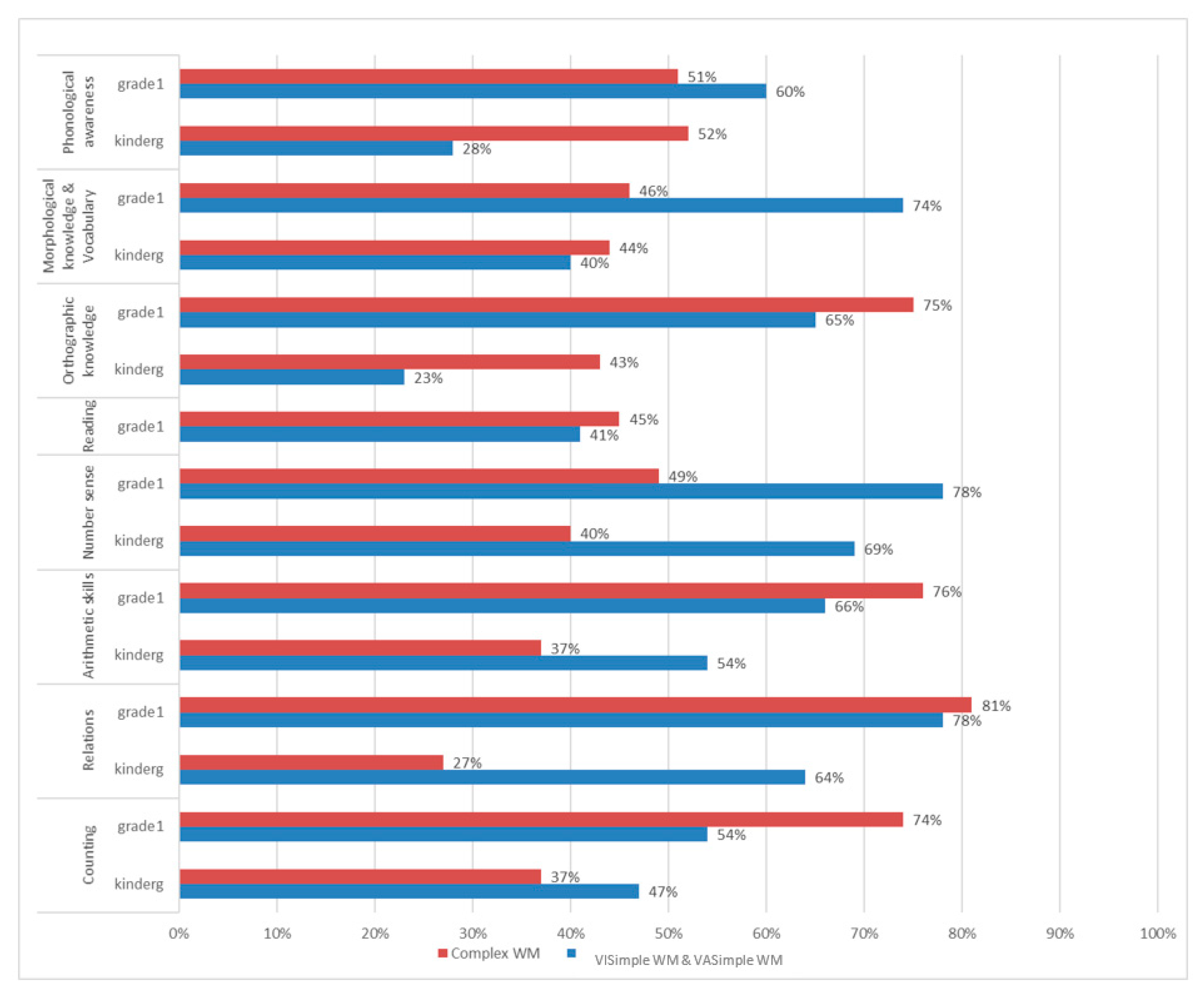
(Chi-Square) | Df (Dgrees of Freedom) | P (Significance) | (Chi-Square Degrees of Freedom) | TLI (Tucker–Lewis Index) | CFI (Comparative Fit Indices) | RMSEA (Root Mean Square Error of Approximation) | |
|---|---|---|---|---|---|---|---|
| Model 1: Simple WM and Early Literacy | 348.071 | 178 | 0.000 | 1.955 | 0.922 | 0.920 | 0.062 |
| Model 2: Complex WM and Early Literacy | 294.870 | 143 | 0.000 | 2.062 | 0.928 | 0.927 | 0.065 |
| Model 3: Simple WM and Language Skills | 193.604 | 121 | 0.000 | 1.600 | 0.915 | 0.911 | 0.066 |
| Model 4: Complex WM and Language Skills | 201.700 | 123 | 0.000 | 1.640 | 0.909 | 0.906 | 0.069 |
| Model 5: Simple WM and Early Numeracy | 497.046 | 282 | 0.000 | 1.763 | 0.900 | 0.900 | 0.055 |
| Model 6: Complex WM and Early Literacy | 424.761 | 238 | 0.000 | 1.785 | 0.910 | 0.909 | 0.056 |
| Model 7: Simple WM and Math Skills | 208.802 | 153 | 0.002 | 1.365 | 0.931 | 0.928 | 0.052 |
| Model 8: Complex WM and Math Skills | 217.889 | 157 | 0.001 | 1.388 | 0.928 | 0.925 | 0.053 |
| Kindergarten N = 250, First Grade N = 137 WM-Working Memory |
| Reading | Orthographic Knowledge | Morphological Knowledge and Vocabulary | Phonological Awareness | ||||
|---|---|---|---|---|---|---|---|
| Grade1 | Kindergarten | Grade1 | Kindergarten | Grade1 | Kindergarten | Grade1 | |
| Simple Verbal Auditory WM | 0.39 * | - | 0.75 ** | 0.89 *** | 0.85 *** | 0.38 * | 0.77 *** |
| Fisher correlation | p < 0.01 | p = 0.05 | p < 0.01 | ||||
| Simple Visual Spatial WM | 0.51 * | 0.35 * | - | - | - | - | - |
| Fisher correlation | p < 0.01 | ||||||
| Complex WM | 0.67 *** | 0.43 *** | 0.87 *** | 0.44 *** | 0.68 *** | 0.52 *** | 0.71 *** |
| Fisher correlation | p < 0.01 | p < 0.01 | p < 0.01 | ||||
| Counting | Relations | Arithmetic Skills | Number Sense | |||||
|---|---|---|---|---|---|---|---|---|
| Kinder-Garten | Grade1 | Kinder-Garten | Grade1 | Kinder-Garten | Grade1 | Kinder-Garten | Grade1 | |
| Simple Verbal Auditory WM | 0.47 *** | 0.69 ** | 0.57 *** | 0.73 * | 0.67 *** | 0.67 *** | 0.49 *** | - |
| Fisher correlation | p < 0.05 | p < 0.05 | p = 0.05 | p < 0.01 | ||||
| Simple Visual Spatial WM | 0.46 *** | - | 0.56 ** | 0.51 * | 0.29 ** | 0.46 * | 0.67 *** | 0.83 * |
| Fisher correlation | p < 0.01 | p < 0.05 | p < 0.05 | p < 0.01 | ||||
| Complex WM | 0.59 *** | 0.86 ** | 0.54 ** | 0.89 * | 0.61 *** | 0.87 *** | 0.63 *** | 0.70 ** |
| Fisher correlation | p < 0.01 | p < 0.01 | p < 0.01 | p < 0.05 | ||||
Disclaimer/Publisher’s Note: The statements, opinions and data contained in all publications are solely those of the individual author(s) and contributor(s) and not of MDPI and/or the editor(s). MDPI and/or the editor(s) disclaim responsibility for any injury to people or property resulting from any ideas, methods, instructions or products referred to in the content. |
© 2023 by the authors. Licensee MDPI, Basel, Switzerland. This article is an open access article distributed under the terms and conditions of the Creative Commons Attribution (CC BY) license (https://creativecommons.org/licenses/by/4.0/).
Share and Cite
Shvartsman, M.; Shaul, S. The Role of Working Memory in Early Literacy and Numeracy Skills in Kindergarten and First Grade. Children 2023, 10, 1285. https://doi.org/10.3390/children10081285
Shvartsman M, Shaul S. The Role of Working Memory in Early Literacy and Numeracy Skills in Kindergarten and First Grade. Children. 2023; 10(8):1285. https://doi.org/10.3390/children10081285
Chicago/Turabian StyleShvartsman, Marina, and Shelley Shaul. 2023. "The Role of Working Memory in Early Literacy and Numeracy Skills in Kindergarten and First Grade" Children 10, no. 8: 1285. https://doi.org/10.3390/children10081285
APA StyleShvartsman, M., & Shaul, S. (2023). The Role of Working Memory in Early Literacy and Numeracy Skills in Kindergarten and First Grade. Children, 10(8), 1285. https://doi.org/10.3390/children10081285





